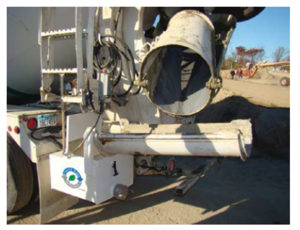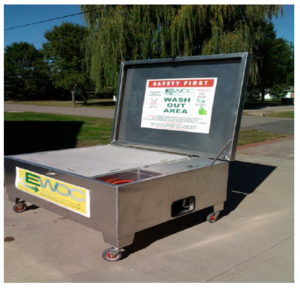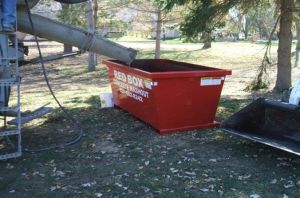
Difference between revisions of "Construction stormwater best management practice – Concrete, paint, stucco and other washout guidance"
m |
|||
| (4 intermediate revisions by one other user not shown) | |||
| Line 42: | Line 42: | ||
There are many BMP options for disposal of liquid and solid wastes from washout activities. Many ready mix trucks are now equipped with the ability to collect chute wash water and solids and return them to the concrete plant for recycling or re-use. | There are many BMP options for disposal of liquid and solid wastes from washout activities. Many ready mix trucks are now equipped with the ability to collect chute wash water and solids and return them to the concrete plant for recycling or re-use. | ||
| + | |||
| + | [[File:Concrete_washout_service.jpg|left|thumb|300 px|alt=This photo shows Concrete washout service|<font size=3>Concrete washout service</font size>]] | ||
Services are also available for hire that deliver a prefabricated washout container to collect concrete chute rinse water as well as wash water from tools and equipment generated on-site. Some services provide the containers alone without providing maintenance and disposal of materials, while other companies offer complete service that includes delivery of containers and regular pickups of solid and liquid waste materials. If these options are not available, the site owner and contractor can install a washout containment facility. A leak-proof container can be purchased or constructed onsite using an impermeable plastic or vinyl liner. The operators at the site will need to ensure no rips or tears develop in the liners or the liner will need to be replaced. | Services are also available for hire that deliver a prefabricated washout container to collect concrete chute rinse water as well as wash water from tools and equipment generated on-site. Some services provide the containers alone without providing maintenance and disposal of materials, while other companies offer complete service that includes delivery of containers and regular pickups of solid and liquid waste materials. If these options are not available, the site owner and contractor can install a washout containment facility. A leak-proof container can be purchased or constructed onsite using an impermeable plastic or vinyl liner. The operators at the site will need to ensure no rips or tears develop in the liners or the liner will need to be replaced. | ||
| − | |||
| − | |||
Washout facilities should be designed to promote evaporation where feasible to harden the concrete or other washout wastes for disposal as a solid waste. Hardened concrete can also be crushed for reuse as a construction material. However, if stored liquids have not evaporated and the washout is nearing capacity, vacuum and dispose of the waste in an approved manner. The local municipal wastewater treatment plant may be contacted to determine if there are special disposal requirements for concrete or other washout waters at their facility. | Washout facilities should be designed to promote evaporation where feasible to harden the concrete or other washout wastes for disposal as a solid waste. Hardened concrete can also be crushed for reuse as a construction material. However, if stored liquids have not evaporated and the washout is nearing capacity, vacuum and dispose of the waste in an approved manner. The local municipal wastewater treatment plant may be contacted to determine if there are special disposal requirements for concrete or other washout waters at their facility. | ||
| Line 53: | Line 53: | ||
====Road construction concrete cutting or grinding slurry==== | ====Road construction concrete cutting or grinding slurry==== | ||
| − | Other operations on-site such as saw cutting, coring, grinding and grooving or construction of exposed- aggregate concrete surfaces may generate a similar liquid wastewater. Process wastewater generated by these operations cannot be discharged into any of the nation’s waterways. The MPCA recommends that liquid and solid wastes generated by these operations be handled in accordance with the fact sheet Road Construction Concrete Slurry Guidance found | + | Other operations on-site such as saw cutting, coring, grinding and grooving or construction of exposed- aggregate concrete surfaces may generate a similar liquid wastewater. Process wastewater generated by these operations cannot be discharged into any of the nation’s waterways. The MPCA recommends that liquid and solid wastes generated by these operations be handled in accordance with the fact sheet Road Construction Concrete Slurry Guidance found [http://www.pca.state.mn.us/index.php/water/water-types-and-programs/stormwater/construction-stormwater/road-construction-concrete-slurry-guidance.html here.] |
====Local requirements==== | ====Local requirements==== | ||
| Line 71: | Line 71: | ||
====Additional information==== | ====Additional information==== | ||
| − | United States Environmental Protection Agency [https://www3.epa.gov/npdes/pubs/concretewashout.pdf Concrete Washout Guidelines] | + | United States Environmental Protection Agency [https://www3.epa.gov/npdes/pubs/concretewashout.pdf Concrete Washout Guidelines] |
Minnesota Department of Transportation [http://www.dot.state.mn.us/environment/pdf/concrete-washout.pdf Concrete Guidance] (except for reference to ground contact with low infiltration soils) | Minnesota Department of Transportation [http://www.dot.state.mn.us/environment/pdf/concrete-washout.pdf Concrete Guidance] (except for reference to ground contact with low infiltration soils) | ||
For more information, call the MPCA Stormwater Hotline at 651-757-2119 or 800-657-3804. | For more information, call the MPCA Stormwater Hotline at 651-757-2119 or 800-657-3804. | ||
| + | |||
| + | <noinclude> | ||
| + | [[Category:Level 3 - Best management practices/Construction practices/Fact or summary sheet]] | ||
| + | </noinclude> | ||
Latest revision as of 18:22, 23 November 2022
For a printable version of this page, click here.
Concrete, paint, stucco and other washout guidance
National Pollutant Discharge Elimination System/State Disposal System Construction Stormwater Permit requirements
Use this guidance for managing all liquid and solid wastes generated by washout operations (concrete, stucco, paint, form release oils, curing compounds, and other construction materials) related to construction activity on National Pollutant Discharge Elimination System/State Disposal System (NPDES/SDS) construction stormwater permitted sites. To protect water quality, the NPDES Construction Stormwater Permit requires best management practices (BMPs) for concrete and other washout wastes on construction sites.
Background
The chutes of concrete mixers and hoppers of concrete pumps are typically rinsed out after delivery of concrete. Tools, hand mixers and wheel barrows are also washed to prevent hardening. Hardened concrete is relatively benign. However, liquid concrete wash water is a caustic material due to a high pH and it contains hazardous metals such as chromium. These materials can leach into the ground and contaminate groundwater. The high pH can inhibit plant growth and harm aquatic life if the runoff migrates to a lake or stream. Solids from liquid waste that are improperly disposed of can clog storm drain pipes and cause flooding. In order to comply with the prohibition of discharging any materials other than treated stormwater, there must be a means to prevent the discharge of washout water from the cleanup of stucco, paint, form release oils, curing compounds, and other construction materials.
The Minnesota Pollution Control Agency (MPCA) believes that groundwater and surface water can be protected from liquid concrete and other washout wastes through proper use of BMPs at NPDES/SDS construction stormwater permitted sites. Installing washout facilities not only prevents pollution but also is a matter of good housekeeping at a construction site.
Washout at construction sites
Washout facilities are used to contain all concrete and liquid wash water generated by the construction activity. Liquid and solid washout wastes must be contained in a leak-proof container and cannot contact the ground. The washout containers should be covered to prevent exposure to rainfall and potential overflow.
Washout facilities should also be used for cleaning other cementitious (cement-like) construction materials from tools and equipment such as stucco, mortar, plaster and grout. Depositing the wash water into a container allows evaporation and hardening to occur for easier disposal and to prevent runoff of liquids.
While the Construction Stormwater Permit does not allow concrete chute rinse water to come into contact with the ground, the permit does allow the wasting, the end of the load of plastic structural concrete to come into contact with the ground. After drying, the remaining solids may be used as a fill material, a component in recycled aggregate or any other commercially useful application. Up to 0.5 cubic yards of concrete solids may be managed/buried on-site. If concrete solids are buried on-site, they should be at least two feet below the surface and must not be buried within three feet of the groundwater table. Quantities larger than 0.5 cubic yards of concrete solids must either be managed with the rest of the site’s solid wastes or obtain an approval from the MPCA’s solid waste program for other beneficial use options.
There are circumstances where concrete washout may be allowed onto a prepared compacted road bed. This allowance is intended for slip form paving type machines that cannot be readily moved off the paving area to a washout station. The area where wash water will flow onto must be compacted and will be paved over the next day. There must be a barrier of some type to keep the wash water on the compacted road bed until it dries. This allowance is not intended for truck washouts.
A concrete washout sign must be installed at each temporary washout facility to inform the site personnel to use the designated facilities. The facility should be located close to the concrete pouring or mixing operation and be easily accessible by concrete mix trucks. It is also important to locate the facility so that spills or overflows will be directed away from storm drain inlets, curb and gutters, water conveyances or surface waters. The facility will need to be inspected regularly for leaks, damage, or potential overflow and receive regular maintenance.
Washing of applicators and containers used for paint, concrete, or other materials
The permittee must comply with the prohibition of discharges other than stormwater that includes the washout and cleanout of stucco, paint, concrete, form release oils, curing compounds, and other construction materials. The permittee must provide effective containment for all liquid and solid wastes generated by washout operations and provide an effective means to eliminate the discharge of these wastes to the site or receiving waters. To comply, the permittee should evaluate and incorporate methods in the Stormwater Pollution Prevention Plan to prevent these discharges such as:
- Direct all wash water into a leak-proof container or leak-proof pit. The container or pit must be designed so that no overflows can occur due to inadequate sizing or precipitation;
- Handle washout or cleanout wastes as follows:
- Do not dump liquid wastes in storm sewers
- Dispose of liquid wastes properly
- Remove and dispose of hardened concrete waste consistent with the handling of other construction wastes
- Locate any washout or cleanout activities as far away as possible from surface waters and stormwater inlets or conveyances, and, to the extent practicable, designate areas to be used for these activities and conduct such activities only in these areas.
Best management practices
There are many BMP options for disposal of liquid and solid wastes from washout activities. Many ready mix trucks are now equipped with the ability to collect chute wash water and solids and return them to the concrete plant for recycling or re-use.
Services are also available for hire that deliver a prefabricated washout container to collect concrete chute rinse water as well as wash water from tools and equipment generated on-site. Some services provide the containers alone without providing maintenance and disposal of materials, while other companies offer complete service that includes delivery of containers and regular pickups of solid and liquid waste materials. If these options are not available, the site owner and contractor can install a washout containment facility. A leak-proof container can be purchased or constructed onsite using an impermeable plastic or vinyl liner. The operators at the site will need to ensure no rips or tears develop in the liners or the liner will need to be replaced.
Washout facilities should be designed to promote evaporation where feasible to harden the concrete or other washout wastes for disposal as a solid waste. Hardened concrete can also be crushed for reuse as a construction material. However, if stored liquids have not evaporated and the washout is nearing capacity, vacuum and dispose of the waste in an approved manner. The local municipal wastewater treatment plant may be contacted to determine if there are special disposal requirements for concrete or other washout waters at their facility.
If the waste is stored onsite, remove the liquids or cover the washout facility before predicted rainstorms to prevent overflows. Companies that offer prefabricated and watertight washout containers generally offer a vacuum service to remove the liquid material. In case of a spill, immediately contain the spread of the spill, recover spilled materials, clean up the area and properly dispose of materials. Hardened concrete solids can be removed whole or broken up first depending on the type of equipment available on-site. In accordance with Minn. R. 7035.2860, subp. 4, item I; the hardened concrete can be used as a substitute for conventional aggregate. If the material is not utilized in accordance with the standing beneficial use determination referenced above, up to 0.5 cubic yards of concrete washout solids may be managed on-site. If concrete washout solids are buried on-site, they should be at least two feet below the surface and must not be buried in the groundwater table. Quantities larger than 0.5 cubic yards of concrete washout solids must either be managed with the rest of the sites solid wastes or obtain an approval from the MPCA’s Solid Waste program for other beneficial use options.
Road construction concrete cutting or grinding slurry
Other operations on-site such as saw cutting, coring, grinding and grooving or construction of exposed- aggregate concrete surfaces may generate a similar liquid wastewater. Process wastewater generated by these operations cannot be discharged into any of the nation’s waterways. The MPCA recommends that liquid and solid wastes generated by these operations be handled in accordance with the fact sheet Road Construction Concrete Slurry Guidance found here.
Local requirements
In addition to state requirements, please note that there may be city, county or watershed management organization requirements that may be more stringent than those found in the NPDES/SDS Construction Stormwater Permit.
Definitions
Concrete-chute rinse-off water: Liquid wastes generated when a ready mix truck operator washes non-structural concrete materials off the chutes used to deliver concrete to a project.
Concrete equipment and tools rinse-off water: Liquid wastes generated when a concrete contractor or finisher washes non-structural concrete materials off tools or equipment used to place or finish concrete.
Plastic concrete is that freshly mixed structural concrete which is pliable and capable of being molded or shaped like a lump of modeling clay.
Hardened structural concrete is a strong, non-combustible, durable, abrasion-resistant and practically impermeable material.
Additional information
United States Environmental Protection Agency Concrete Washout Guidelines
Minnesota Department of Transportation Concrete Guidance (except for reference to ground contact with low infiltration soils)
For more information, call the MPCA Stormwater Hotline at 651-757-2119 or 800-657-3804.
This page was last edited on 23 November 2022, at 18:22.


